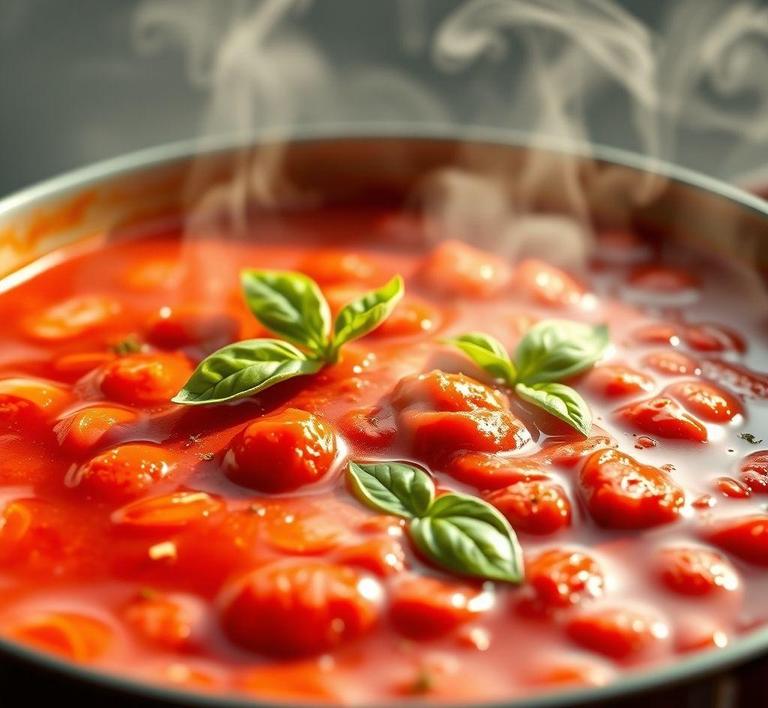If you’ve ever made a big batch of homemade tomato pasta sauce and found yourself with leftovers, you might be wondering whether it’s okay to refreeze it. While freezing tomato pasta sauce initially is a great way to store it for later, the question of whether you can safely refreeze it comes up often. Refreezing tomato pasta sauce isn’t as simple as just tossing it back into the freezer, as doing so can affect the texture, flavor, and quality. But don’t worry-there are ways to ensure your sauce stays tasty and safe for your next pasta night. In this guide, we’ll walk you through everything you need to know about refreezing tomato pasta sauce, including the best methods and tips for maintaining its deliciousness!
Can You Refreeze Tomato Pasta Sauce?

Refreezing tomato pasta sauce is a topic that stirs up some controversy and confusion in many kitchens. The general rule of thumb when it comes to freezing sauces, especially those with a tomato base, is that while it’s possible to refreeze them, the quality and texture can suffer significantly. However, it all depends on how the sauce was initially frozen and how you handle the refreezing process. The key to successfully refreezing tomato pasta sauce lies in understanding the principles of freezing and thawing, and how this can affect the sauce’s ingredients, consistency, and flavor.
Tomato-based pasta sauces typically contain a variety of ingredients like tomatoes, herbs, oils, and sometimes dairy, all of which react differently to freezing. The high water content in tomatoes, for instance, can lead to a change in texture once frozen and thawed. When refrozen, this change is often amplified. That said, if you’ve followed the proper steps for freezing and thawing your tomato sauce, and you’re not overly concerned with minor changes in texture or flavor, then refreezing is an option.
The real problem arises when tomato pasta sauce is thawed and refrozen multiple times. Each cycle of freezing and thawing introduces the possibility of bacterial growth, a decline in flavor quality, and an unpleasant texture. Sauces that have been frozen, thawed, and then re-frozen can develop an off-putting watery consistency and may even separate or curdle if dairy was included. This can result in a loss of the smooth, rich, and velvety texture that we associate with a good pasta sauce.
How To Refreeze Tomato Pasta Sauce?
To ensure you’re refreezing your tomato pasta sauce as safely and effectively as possible, there are a few key steps to follow. Here’s a breakdown of the process:
-
Cool the Sauce Completely Before Freezing
Whether you’re freezing the sauce for the first time or preparing it for a second round of freezing, cooling it down is an essential step. Let your tomato pasta sauce cool to room temperature. This prevents the formation of ice crystals in the sauce and helps retain its flavor and texture. Cooling the sauce also helps avoid condensation inside the container, which could make your sauce watery when thawed.
-
Store in Airtight Containers
When you’re preparing to freeze tomato pasta sauce, make sure to store it in airtight containers or freezer bags. If you use freezer bags, lay them flat to freeze, as this will help the sauce freeze more quickly and evenly. For refreezing, be mindful that the sauce has already undergone one freeze cycle. Choose containers that are sturdy and not too full-this allows for some expansion as the sauce freezes again.
-
Avoid Freezing with Dairy
If you’ve added dairy to your sauce (like cream or cheese), it’s best to freeze the sauce without it. Dairy can separate and curdle when frozen and thawed multiple times. If you need a creamy finish, you can always add dairy once you’ve thawed the sauce and are ready to serve. This will prevent the dairy from being damaged during the freezing and refreezing process.
-
Thaw Properly Before Refreezing
The key to retaining quality when refreezing is thawing your tomato pasta sauce properly. Never leave it out at room temperature for long periods, as this promotes bacterial growth. Instead, thaw it slowly in the refrigerator overnight. If you’re in a rush, you can use a microwave, but be cautious not to overheat it or the sauce may become too watery. Once thawed, you can then decide if you need to refreeze it.
-
Keep Track of Storage Time
While refreezing tomato pasta sauce is not ideal, you can do it in a pinch. However, it’s crucial to monitor the length of time your sauce spends in the freezer. Ideally, pasta sauce should be consumed within 1-2 months of the first freeze, and no more than 3 months for the second freeze. After that, even if it’s safe to eat, the quality will be significantly compromised.
Quality Impact
Refreezing tomato pasta sauce inevitably has an impact on its quality. The texture, flavor, and overall appeal of the sauce can diminish with each cycle of freezing and thawing.
- Texture: The most noticeable impact is often on texture. Freezing causes the water content in the sauce to form ice crystals, and when it’s thawed, these ice crystals melt, leading to a runnier, more watery consistency. The second freeze and thaw can make this process worse, causing the sauce to separate or become more liquid than it originally was. If you’re dealing with a chunky tomato sauce, the vegetables or herbs might break down more during the refreezing process, making the sauce less visually appealing.
- Flavor: Refreezing can also alter the flavor of the sauce. While the flavor may remain generally intact, the sauce may lose some of its brightness or become slightly more acidic. This is especially true for fresh herb-based tomato sauces, as the delicate herbal notes can fade after multiple freezes. If your sauce includes garlic or onions, they may taste more muted or have a slight “off” flavor due to the freezing and thawing process.
- Separation and Curds: If your tomato pasta sauce contains dairy (like cream, butter, or cheese), refreezing can lead to curdling or separation. Dairy doesn’t freeze as smoothly as tomatoes do, and the texture can become unpleasantly lumpy after being frozen and thawed multiple times. To preserve the integrity of the dairy in your sauce, it’s better to freeze the tomato sauce without it, and add dairy only when reheating.
- Nutritional Quality: Although freezing and refreezing will not typically affect the nutritional value of your sauce in the long run, there can be some minimal degradation of vitamins and minerals after multiple cycles. Most nutrients are fairly stable in the freezing process, but prolonged storage (beyond a few months) can cause slight loss of potency, especially with heat-sensitive compounds like vitamin C.
While it is possible to refreeze tomato pasta sauce, it’s not ideal if you want to preserve its original quality. The texture may suffer, flavors could dull, and the consistency might become more watery or separated. To minimize these negative effects, it’s crucial to freeze and thaw the sauce carefully and avoid refreezing it multiple times. Ideally, freeze only the portions of tomato sauce you plan to use, and limit refreezing to one cycle.
If you absolutely must refreeze, take the time to cool your sauce properly, store it in airtight containers, and ensure it has been thawed in a controlled manner. By following these guidelines, you can maintain the best possible quality and enjoy your homemade pasta sauce without too much compromise. However, for optimal flavor and texture, it’s always best to consume your tomato pasta sauce within a few weeks of its initial freeze.
Is It Safe To Refreeze Tomato Pasta Sauce?
Refreezing tomato pasta sauce is a topic that often sparks debates in the culinary world, particularly because tomato-based sauces contain delicate ingredients like tomatoes, herbs, and oils that can be affected by temperature fluctuations. So, is it safe to refreeze tomato pasta sauce? The answer depends on several factors, but let’s break them down in detail.
When tomato pasta sauce is frozen for the first time, the process halts the growth of bacteria and preserves the sauce for long-term storage. However, freezing causes the liquid in the sauce to expand and ice crystals to form, which can alter the texture and taste once it’s thawed. This isn’t necessarily harmful, but it can make the sauce less appetizing in some cases.
Refreezing tomato pasta sauce after it has been thawed presents more risks, particularly if the sauce was not handled properly during its thawing period. The primary concern here is that thawing and refreezing can lead to the growth of bacteria, especially if the sauce is left at room temperature for too long during the thawing process. When frozen foods go through cycles of thawing and refreezing, they are exposed to these temperature fluctuations, which creates an environment where harmful microorganisms can thrive.
From a food safety standpoint, it’s essential that tomato pasta sauce (or any food, for that matter) is kept at a consistent and safe temperature. If you’ve thawed the sauce in the refrigerator and have kept it at a safe temperature (below 40°F or 4°C), refreezing it might still be safe, though you may notice changes in its flavor and texture.
Signs That Tomato Pasta Sauce Should Not Be Refrozen
Even though refreezing tomato pasta sauce can technically be done, certain signs indicate that it’s better not to proceed. Here are the key red flags to look out for:
- Off Odor: If the sauce smells sour, rancid, or just “off” after being thawed, it’s a clear sign that it has started to spoil. The tomatoes and other ingredients in the sauce are perishable, and if any of them have gone bad, the sauce is no longer safe to consume, regardless of whether you refreeze it.
- Separation or Texture Issues: After thawing, it’s common for the sauce to separate slightly. However, if the sauce has developed a very thin, watery consistency or the separation looks extreme, it might have undergone some changes in quality that are irreversible. Refreezing it could worsen these issues.
- Visible Mold: Mold growth is a definite indication that your sauce has been exposed to bacteria and air for too long. If you notice any mold growth on the surface or inside the container, it’s time to toss the sauce-refreezing it won’t make it safe to eat.
- Improper Storage: If the sauce was thawed improperly-such as being left out at room temperature for too long-it’s best not to refreeze it. Bacteria can proliferate rapidly when food is held in the “danger zone” (between 40°F and 140°F or 4°C to 60°C), and even though freezing can stop this growth temporarily, it won’t kill harmful bacteria.
- Excessive Ice Crystals: While some ice crystals are normal when food is frozen, an overwhelming amount of ice crystals or a freezer burn appearance means the sauce has been exposed to air and fluctuating temperatures. This can lead to a loss of flavor and a poor texture once refrozen.
Common Refreezing Mistakes
When it comes to refreezing tomato pasta sauce, many common mistakes can contribute to poor taste, texture, and even potential foodborne illnesses. Here are a few you’ll want to avoid:
- Thawing at Room Temperature: A common mistake is letting tomato pasta sauce thaw at room temperature, which is dangerous. Room temperature is the perfect breeding ground for bacteria, and once the sauce starts thawing, bacteria can multiply rapidly. Always thaw it in the fridge for a slow and safe thaw.
- Not Storing in Airtight Containers: If you freeze your sauce in containers that aren’t sealed properly, air can get in, leading to freezer burn and degradation in both flavor and texture. Freezing tomato sauce in airtight containers or freezer bags that are tightly sealed will help preserve its quality.
- Refreezing Multiple Times: Every time you freeze, thaw, and refreeze, the quality of the sauce decreases. Refreezing multiple times can make the sauce watery and thin and can cause the tomatoes to lose their fresh, bright flavor. Ideally, only refreeze tomato pasta sauce once.
- Not Labeling Containers: If you don’t label your frozen sauce with the date it was made and frozen, it can be difficult to know how long it’s been in the freezer. If it’s been more than 3-4 months, even if it looks fine, the flavor and texture may have deteriorated significantly, so it’s best to use fresh batches instead.
- Overloading the Freezer: Packing your freezer too tightly with sauce containers can cause uneven freezing, which means that some portions of the sauce might not freeze properly. This can affect the overall safety and quality of the sauce when thawed.
Tips And Tricks For Refreezing Tomato Pasta Sauce
While refreezing tomato pasta sauce isn’t ideal, there are several tips and tricks that can help you do it safely and with minimal loss of quality.
- Cool the Sauce Quickly: If you’ve just cooked the tomato pasta sauce and need to freeze it, cool it down rapidly before placing it in the freezer. This prevents bacteria growth and helps preserve the texture and flavor. You can speed up the cooling process by placing the sauce pot in a sink filled with ice water.
- Portion It Out: Instead of freezing the whole batch, portion out the sauce into smaller amounts. This way, you can thaw only what you need, preventing you from having to refreeze the entire batch again.
- Add Fresh Herbs After Thawing: Fresh herbs like basil or oregano can lose their punch after freezing and thawing. Instead of freezing them with the sauce, try adding them after the sauce has been reheated and you’re ready to serve it.
- Use Freezer-Safe Containers: Invest in freezer-safe glass or BPA-free plastic containers, or use resealable freezer bags for storing your sauce. Glass jars with lids are a great option because they prevent the sauce from absorbing odors and maintain its quality for a longer period.
- Freeze in Thin Layers: For even faster freezing and better preservation, spread the sauce in a thin layer in a freezer bag. This helps the sauce freeze quicker and more evenly, preserving its taste and texture.
- Use within a Few Months: While tomato pasta sauce can last for up to 6 months in the freezer, it’s best to use it within 3 months to ensure the best quality. The longer it stays in the freezer, the more its flavor and texture degrade.
- Reheat Gently: When reheating previously frozen tomato pasta sauce, do so on low heat to avoid separating the oil from the sauce and to preserve the overall consistency.
Conclusion
In conclusion, while refreezing tomato pasta sauce isn’t the worst thing you can do, it comes with some risks. Refreezing after proper storage and safe thawing is generally acceptable, but the quality of the sauce will inevitably degrade. It’s important to follow best practices when freezing, thawing, and reheating to maintain the safety and flavor of the sauce. Pay attention to signs of spoilage such as odd odors, mold, and separation, and avoid common mistakes like thawing at room temperature or overloading your freezer. By following these guidelines, you can ensure that your tomato pasta sauce remains as fresh and flavorful as possible after each freezing cycle.


